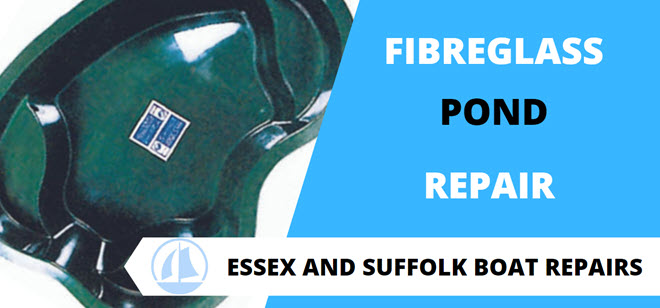Welcome to todays post where we are going to be discussing the top 5 signs that your fibreglass pond needs repair. Many of you know of our repairing expertise with boats, but are probably not aware that we also install fibreglass pond linings as well as repair them should the need arise.
Maintaining a fibreglass pond is not only essential for preserving its aesthetic appeal but also for ensuring the longevity of the structure and the well-being of its aquatic inhabitants.
Fibreglass, renowned for its durability and resilience, plays a pivotal role in the construction of ponds, offering a reliable solution that withstands the test of time.
As pond owners and enthusiasts, it’s crucial to recognize the significance of regular maintenance and timely repairs to safeguard the investment made in creating a beautiful aquatic environment.
Fibreglass, a composite material composed of glass fibres embedded in a polymer resin, has become the material of choice for constructing ponds due to its remarkable durability and resistance to various environmental factors.
Unlike traditional materials, fibreglass provides a sturdy foundation that can endure the challenges posed by weather, ground movement, and the natural aging process.
Its non-porous nature also minimizes the risk of water leakage, ensuring a more stable and sustainable aquatic ecosystem within the pond.
As we delve into the top signs that indicate the need for a fibreglass pond repair, it’s essential to recognize the integral role that fibreglass plays in fortifying the structural integrity of ponds.
Let’s explore the subtle yet crucial indicators that your fibreglass pond might be signalling for attention, and why addressing them promptly can make a substantial difference in the overall health and longevity of your aquatic haven.
Table of Contents
Sign 1: Surface Cracks
Surface cracks, though seemingly innocuous at first glance, can be early indicators of underlying issues that, if left unattended, may lead to more significant problems for your fibreglass pond.
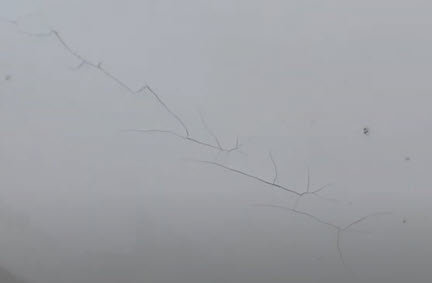
- Development Over Time:
- Surface cracks often develop gradually as a result of the natural aging process and exposure to environmental elements. Fibreglass, while robust, can be susceptible to the effects of prolonged exposure to sunlight, rain, and temperature fluctuations.
- The constant expansion and contraction caused by changes in weather conditions, especially in regions with extreme climates, can contribute to the formation of fine cracks on the pond’s surface over time.
- Potential Causes:
- Weather Exposure: Intense sunlight and UV radiation can cause the outer layer of the fibreglass to weaken, leading to the development of cracks. Harsh weather conditions, such as freezing temperatures followed by rapid thawing, can also contribute to this phenomenon.
- Ground Movement: If the pond is installed on unstable or shifting ground, the movement of the soil beneath can create stress on the fibreglass, resulting in cracks. This is particularly common in areas prone to soil erosion or seismic activity.
- Improper Installation: In some cases, surface cracks may be a consequence of suboptimal installation practices. Issues such as uneven foundation, inadequate support structures, or improper bonding of fibreglass layers during construction can contribute to the development of cracks.
- Importance of Prompt Addressal:
- Addressing surface cracks promptly is crucial to prevent water leakage, which can have detrimental effects on both the structural integrity of the pond and the health of its inhabitants.
- Unchecked cracks may provide pathways for water to seep into the fibreglass layers, leading to potential damage to the pond’s foundation. This can result in a compromised structural integrity that may necessitate more extensive and costly repairs if left unattended.
- Early detection and repair of surface cracks not only preserve the aesthetics of the pond but also contribute to the long-term health of the fibreglass structure, ensuring its ability to withstand the challenges posed by the environment.
In the next section, we will delve into the second sign of potential issues in fibreglass ponds: discoloration or staining, and what these signs might indicate about the overall condition of the pond.
Sign 2: Discoloration or Staining
The presence of discoloration or staining on the surface of your fibreglass pond can serve as a visual cue, suggesting potential underlying issues that demand your attention.
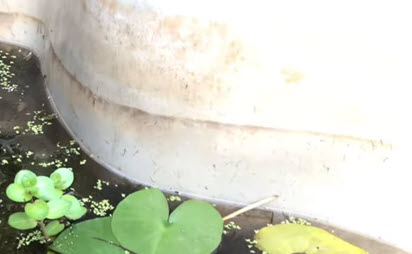
Understanding the origins of these stains is crucial for effective pond maintenance and ensuring the continued health of your aquatic environment.
- Indicators of Underlying Issues:
- Algae Growth: Discoloration in the form of greenish or brownish stains may indicate the presence of algae. Algae thrive in environments with excess nutrients and sunlight, and their growth can negatively impact water quality and the overall balance of the pond ecosystem.
- Mineral Deposits: White or chalky stains on the fibreglass surface are often a result of mineral deposits in the water. These deposits may come from hard water sources or dissolved minerals, and their accumulation can affect both the appearance of the pond and the well-being of aquatic life.
- Chemical Imbalances: Discoloration can also be a consequence of chemical imbalances in the pond water. Imbalances in pH levels or the presence of harmful chemicals can manifest as stains on the fibreglass, signaling potential risks to the health of the aquatic ecosystem.
- Potential Sources of Stains:
- Algae: Algae growth is a natural part of pond ecosystems, but excessive growth can be indicative of nutrient imbalances or inadequate filtration.
- Mineral Deposits: Water with high mineral content, commonly referred to as hard water, can result in the accumulation of mineral deposits on the pond surface.
- Chemical Imbalances: Poor water quality management, including imbalances in pH levels or the use of unsuitable chemicals, can contribute to staining on the fibreglass.
- Cleaning Tips and Identification of Professional Repair Needs:
- DIY Cleaning: Minor stains caused by algae or mineral deposits can often be addressed through DIY cleaning methods. Introduce pond-friendly cleaning solutions or mild detergents to remove stains without harming aquatic life.
- Professional Assessment: If stains persist despite DIY efforts or if they are indicative of more significant issues, it’s crucial to seek professional assessment. A pond specialist can conduct water tests to identify chemical imbalances and recommend appropriate treatments.
- Timely Action: Promptly addressing stains is essential to prevent further deterioration of water quality and potential harm to pond inhabitants. Regular monitoring and swift action can ensure a vibrant and visually appealing pond environment.
Understanding the causes of discoloration or staining is the first step toward maintaining a pristine fibreglass pond.
In the next section, we’ll explore another critical sign: water loss, and how it can be an indication of potential leaks or structural issues.
Sign 3: Water Loss
A noticeable drop in the water level of your fibreglass pond can be a cause for concern, signalling potential leaks or structural issues that demand immediate attention.
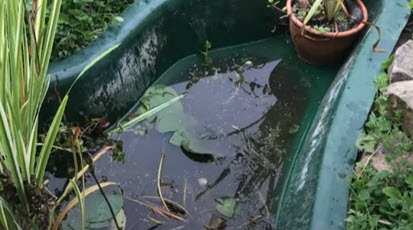
Understanding the sources of water loss and promptly addressing them is vital for preserving the integrity of your pond and sustaining a healthy aquatic ecosystem.
- Significance of Water Level Changes:
- Leak Indication: A visible decrease in water level suggests the presence of leaks in the pond. These leaks can stem from various sources, compromising the overall structural integrity of the fibreglass and posing a risk to the pond’s functionality.
- Environmental Impact: Beyond structural concerns, unaddressed leaks can lead to a wasteful loss of water. Conserving water is not only an ecological responsibility but also crucial for maintaining the proper balance of the pond’s ecosystem.
- Common Areas of Leaks:
- Seams and Joints: Over time, the seams and joints where different sections of fibreglass are connected may become susceptible to wear and tear. The stress from water pressure and environmental factors can compromise these areas, resulting in leaks.
- Damaged Areas: Physical damage, whether from impact or external factors, can create openings in the fibreglass, allowing water to escape. It’s essential to inspect the entire surface for any visible cracks, punctures, or other forms of damage.
- Importance of Timely Repairs:
- Preserving Water Resources: Addressing leaks promptly is crucial to conserve water resources. Every drop lost not only impacts the aesthetic appeal of the pond but also disrupts the delicate balance of the aquatic ecosystem.
- Preventing Structural Damage: Unchecked leaks can lead to more extensive structural damage over time. Water seeping into the fibreglass layers can weaken the material, making repairs more complex and costly if not addressed promptly.
- Maintaining Ecosystem Health: The health of the pond’s flora and fauna relies on a stable water environment. Rapid water loss can disrupt this balance, affecting water quality and potentially harming aquatic life. Timely repairs ensure the continuity of a thriving ecosystem.
- Avoiding Escalation of Costs: Early detection and repair of leaks can prevent the escalation of repair costs. What might start as a minor issue can quickly turn into a major problem if left unattended, necessitating more extensive and expensive repairs.
In the subsequent section, we will explore another crucial sign: irregularities in the pond’s shape or structure. Understanding these signs empowers pond owners to take proactive measures to maintain a beautiful and resilient fibreglass pond.
Sign 4: Irregularities in Pond Shape or Structure
Changes in the shape or structural integrity of your fibreglass pond may signal underlying problems that require careful examination. Recognizing these irregularities early on is crucial for preserving the pond’s functionality, aesthetic appeal, and the overall well-being of its inhabitants.
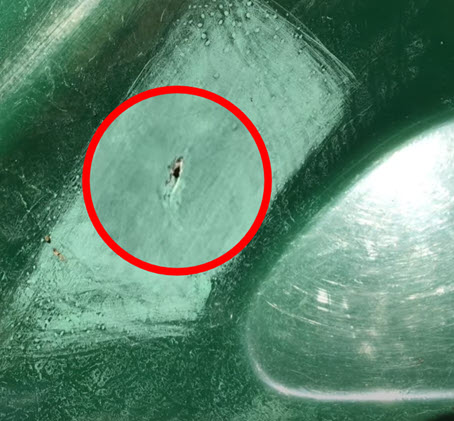
- Indicators of Issues:
- Shifts in Shape: Any noticeable alterations in the pond’s shape, such as bulges, depressions, or warping, can indicate structural irregularities. These changes are often visual cues that something may be compromising the fibreglass’s stability.
- Surface Distortions: Uneven surfaces, wrinkles, or ripples in the fibreglass can suggest deformities in the structural framework of the pond. These irregularities may be more than cosmetic; they may be indicative of problems that need immediate attention.
- Potential Causes:
- Ground Settling: Changes in the ground underneath the pond, such as settling or shifting, can exert stress on the fibreglass structure. This stress may manifest as alterations in the pond’s shape over time.
- Improper Installation: If the pond was not installed on a level and stable foundation, it can lead to structural issues. Improperly distributed weight, inadequate support structures, or failure to follow installation guidelines may result in deformities.
- Impacts and Physical Damage: External factors, such as impacts from heavy objects or machinery, can cause structural damage to the fibreglass. It’s essential to assess the extent of the damage and address it promptly to prevent further deterioration.
- Highlight the Need for Professional Assessment:
- Complexity of Structural Issues: Irregularities in the pond’s shape or structure often require a thorough professional assessment. Structural problems can be complex, and identifying the root cause requires expertise to ensure an effective and lasting solution.
- Preserving Long-Term Integrity: Professional repairs not only address the immediate irregularities but also aim to preserve the long-term integrity of the fibreglass pond. This involves identifying and rectifying the underlying issues to prevent recurrence.
- Preventing Escalation: Ignoring irregularities in the pond’s structure can lead to more extensive and costly damage over time. Professional intervention at the early stages of a problem can prevent the escalation of repair costs and the need for extensive renovations.
Understanding the potential causes of irregularities in the pond’s shape or structure empowers pond owners to take proactive measures. In the subsequent section, we’ll explore another crucial sign: unpleasant odours, and how they may indicate issues with water quality and the overall health of the pond ecosystem.
Sign 5: Unpleasant Odours
The presence of unpleasant odours emanating from your fibreglass pond is not just a nuisance; it can be a clear indication of underlying issues that require immediate attention.
Understanding the causes of these odours is crucial for maintaining a healthy pond environment and ensuring the well-being of both the aquatic ecosystem and its human observers.
- Stagnant Water and Bacterial Growth:
- Odours from Stagnation: Stagnant water, often caused by insufficient aeration or poor circulation, can lead to the build up of organic matter and the proliferation of anaerobic bacteria. This can result in the emission of unpleasant, sometimes foul, odours.
- Bacterial Decomposition: The decomposition of organic debris, such as leaves, algae, or uneaten fish food, in the absence of proper aeration, promotes the growth of bacteria that produce noxious gases. These gases can contribute to the unpleasant smell associated with stagnant water.
- Potential Health Risks and Environmental Impact:
- Health Risks: Unpleasant odours in a pond can signal potential health risks. Bacterial growth in stagnant water may introduce harmful microorganisms that can compromise the health of aquatic life, posing risks to fish and other pond inhabitants.
- Impact on Aquatic Life: The presence of noxious gases can have adverse effects on the overall well-being of the pond’s flora and fauna. Fish may become stressed, and the balance of the ecosystem can be disrupted, potentially leading to fish kills or the decline of desirable aquatic plants.
- Aesthetic and Recreational Impact: Unpleasant odors can detract from the aesthetic appeal of the pond, diminishing its recreational value for pond owners and users. A malodorous pond may discourage outdoor activities and enjoyment of the pond environment.
- Importance of Prompt Addressal:
- Preserving Water Quality: Addressing unpleasant odours promptly is crucial for preserving water quality. The build up of harmful bacteria and gases can compromise the pond’s overall health, leading to imbalances that affect aquatic life.
- Preventing Eutrophication: Stagnant water and bacterial growth contribute to nutrient imbalances that can lead to eutrophication—the excessive growth of algae and aquatic plants. This can further deplete oxygen levels and exacerbate the unpleasant odours, creating a negative feedback loop.
- Proactive Pond Maintenance: Implementing proactive pond maintenance measures, such as aeration, regular cleaning, and proper filtration, is essential for preventing the conditions that lead to unpleasant odours. This ensures the long-term health and vibrancy of the pond ecosystem.
Understanding the relationship between unpleasant odours and the health of your fibreglass pond is key to maintaining a thriving aquatic environment.
In the next section, we’ll summarize the importance of addressing these signs promptly and provide practical tips for DIY repairs as well as guidance on when to seek professional assistance.
Importance of Timely Repairs
Recognizing and addressing the signs of wear and tear in your fibreglass pond promptly is not merely about preserving its visual appeal; it is a fundamental step in maintaining its functionality, the health of its inhabitants, and the longevity of the pond itself. Here’s why a timely fibreglass pond repair is of paramount importance:
- Preservation of Structural Integrity:
- Addressing signs such as surface cracks, discoloration, water loss, irregularities in shape, and unpleasant odours promptly is essential for preserving the structural integrity of the fibreglass pond. Timely repairs prevent the escalation of minor issues into major structural problems.
- Prevention of Further Damage:
- Neglecting repairs can lead to a snowball effect, where a small crack or stain evolves into a more significant issue. Water loss, for instance, can exacerbate structural weaknesses, making repairs more complex and costly as time goes on.
- Conservation of Water Resources:
- Timely repairs, especially in the case of water loss, contribute to the conservation of water resources. Every drop saved by addressing leaks promptly not only maintains the pond’s water level but also aligns with responsible environmental stewardship.
- Sustaining Ecosystem Health:
- A fibreglass pond is a delicate ecosystem, and signs like unpleasant odours can be indicative of imbalances that can harm aquatic life. Timely repairs and proactive maintenance measures are crucial for sustaining a healthy and thriving ecosystem within the pond.
- Avoidance of Escalating Costs:
- Early intervention is cost-effective. Small cracks or stains can often be addressed with minor repairs if detected early. Neglecting these issues can lead to more extensive damage, requiring larger-scale repairs that come with higher costs.
- Long-Term Savings:
- Investing in timely repairs is an investment in the long-term health and longevity of the pond. The cost of preventive and corrective maintenance, when compared to the potential expenses of extensive repairs or even pond replacement, is significantly lower.
- Aesthetic and Recreational Value:
- Timely repairs contribute to the pond’s aesthetic appeal, ensuring it remains an enjoyable and inviting space for recreation. Whether it’s for personal enjoyment, social gatherings, or enhancing property value, a well-maintained fibreglass pond adds to its overall appeal.
In summary, addressing signs of wear and tear promptly is a proactive measure that goes beyond maintaining appearances. It is a commitment to the health and sustainability of your fibreglass pond, providing benefits not only in the short term but also in safeguarding its long-term value and functionality.
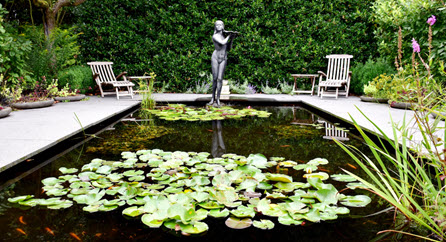
In the next section, we’ll provide practical tips for DIY repairs and guidance on when it’s advisable to seek professional assistance.
DIY Tips for Small Repairs
While major fibreglass pond repairs may require professional expertise, there are several smaller issues that proactive pond owners can address on their own. Here are some basic tips for DIY repairs along with information on suitable repair kits and materials for minor fixes:
- 1. Surface Cracks:
- DIY Repair: Clean the cracked area thoroughly. Apply a marine-grade epoxy or fibreglass repair kit according to the manufacturer’s instructions. Sand the repaired area once the epoxy has cured to achieve a smooth finish.
- Recommended Repair Kit: Look for marine-grade fibreglass repair kits that include epoxy resin, fiberglass cloth, mixing tools, and detailed instructions.
- 2. Discoloration or Staining:
- DIY Repair: Clean the stained area with a mild pond-safe cleaner. For algae stains, consider using a pond algaecide to control growth. For mineral deposits, a vinegar solution can help dissolve the deposits. Rinse thoroughly after cleaning.
- Recommended Materials: Pond-safe cleaners, algaecides, and vinegar for DIY stain removal.
- 3. Water Loss – Small Leaks:
- DIY Repair: Identify the source of the leak and clean the area. Apply a waterproof sealant or a marine-grade epoxy designed for underwater use. Ensure the area is dry before applying the sealant.
- Recommended Repair Material: Underwater epoxy or pond sealant suitable for fibreglass.
- 4. Irregularities in Shape:
- DIY Assessment: If irregularities are minor, use a level to determine the extent of the issue. Adjust the surrounding soil to provide better support. For more significant deformities, consult with a professional.
- 5. Unpleasant Odors:
- DIY Prevention: Enhance pond aeration by adding aeration devices like fountains or air stones. Remove debris regularly to prevent the accumulation of organic matter. Use beneficial bacteria products to aid in natural decomposition.
- Recommended Products: Pond aeration devices, pond skimmers, beneficial bacteria supplements.
Remember, safety is paramount when working around the pond. If you are unsure about the extent of the damage or if the repairs require more than basic DIY interventions, it is advisable to seek professional assistance. DIY repairs are suitable for minor issues, but professional assessment ensures that larger problems are addressed effectively.
In the next section, we’ll discuss situations where professional help is necessary and provide guidance on when to contact experts for comprehensive assessments and more extensive repairs.
When to Seek Professional Help
While a DIY fibreglass pond repair can address minor issues, there are situations where professional assistance becomes necessary. Encouraging pond owners to recognize the limitations of DIY interventions and reach out to experts is crucial for ensuring the comprehensive health and longevity of their fibreglass pond.
- 1. Extensive Structural Damage:
- Signs: If the pond exhibits significant structural damage, such as large cracks, severe irregularities in shape, or widespread deformities, it’s advisable to seek professional help.
- Reasoning: Extensive structural damage requires a thorough assessment by professionals with expertise in fibreglass pond repair. They can identify the root causes and implement comprehensive solutions to restore the pond’s integrity.
- 2. Complex Leak Detection:
- Signs: When dealing with leaks that are challenging to locate or understand, especially if they involve complex plumbing or hidden fibreglass components.
- Reasoning: Professionals have specialized tools and knowledge to perform leak detection in fibreglass ponds accurately. They can identify hidden leaks and provide targeted solutions to prevent further water loss.
- 3. Professional Assessment of Pond Ecosystem:
- Signs: If there are ongoing issues with water quality, persistent odors, or disruptions in the pond ecosystem that DIY measures cannot resolve.
- Reasoning: Pond specialists can conduct comprehensive water tests to assess water quality parameters. They can identify imbalances, recommend suitable treatments, and offer guidance on maintaining a healthy pond environment.
- 4. Large-Scale Repairs and Renovations:
- Signs: When repairs or renovations involve a significant portion of the pond or require extensive modifications.
- Reasoning: Large-scale repairs demand professional expertise and experience. Pond specialists can guide owners through the process, ensuring that repairs are conducted efficiently and effectively.
- 5. Professional Guidance for Preventive Maintenance:
- Signs: Regular occurrences of issues despite DIY efforts, or when pond owners seek guidance on establishing effective preventive maintenance practices.
- Reasoning: Professionals can provide tailored advice on preventive measures, recommend suitable products, and assist in creating a maintenance plan to keep the pond in optimal condition.
Pond owners should view professional assistance as an investment in the long-term health and beauty of their fibreglass pond. By addressing issues promptly and seeking expert guidance, pond owners can enjoy a vibrant and sustainable aquatic environment for years to come.
Conclusion
In conclusion, maintaining a fibreglass pond involves a keen understanding of potential signs of wear and tear that, when left unaddressed, can compromise the structural integrity and overall health of the aquatic environment.
Here’s a recap of the key points discussed:
- Introduction to Fibreglass Pond Maintenance:
- Fibreglass is a durable and resilient material commonly used in pond construction for its ability to withstand environmental challenges.
- Top 5 Signs Your Fibreglass Pond Needs Repairs:
- Surface Cracks: Indicators of potential structural issues that may lead to water leakage.
- Discoloration or Staining: Signifying potential problems with algae, mineral deposits, or chemical imbalances.
- Water Loss: A noticeable drop in water level, suggesting leaks that need immediate attention.
- Irregularities in Pond Shape or Structure: Changes in shape or structural integrity that may indicate ground settling, improper installation, or impacts.
- Unpleasant Odours: Odours arising from stagnant water or bacterial growth, signalling potential risks to water quality and aquatic life.
- Importance of Timely Repairs:
- Addressing signs promptly preserves structural integrity, prevents further damage, conserves water resources, sustains ecosystem health, and avoids escalating costs.
- DIY Tips for Small Repairs:
- Provided basic tips for addressing minor issues such as surface cracks, discoloration, water loss, and unpleasant odours.
- When to Seek Professional Help:
- Outlined situations where professional assistance is necessary, including extensive structural damage, complex leak detection, professional ecosystem assessment, and large-scale repairs.
- Conclusion:
- Proactive maintenance is essential for the long-term health and vibrancy of fibreglass ponds. Recognizing and addressing signs of wear and tear promptly ensures the pond remains an aesthetically pleasing and environmentally sustainable feature on your property.
- Invitation for Professional Assistance:
- Encourage readers to reach out for professional assistance if they notice any of the mentioned signs or if they encounter challenges that go beyond the scope of DIY repairs. Professional guidance ensures a thorough assessment and effective solutions tailored to the unique needs of their fibreglass pond.
By taking proactive measures and staying vigilant to signs of deterioration, pond owners can enjoy the beauty and benefits of their fibreglass ponds for years to come.
For any concerns or assistance, don’t hesitate to contact us here, we specialize in everything fibreglass and pond repairs are one of our many services.
